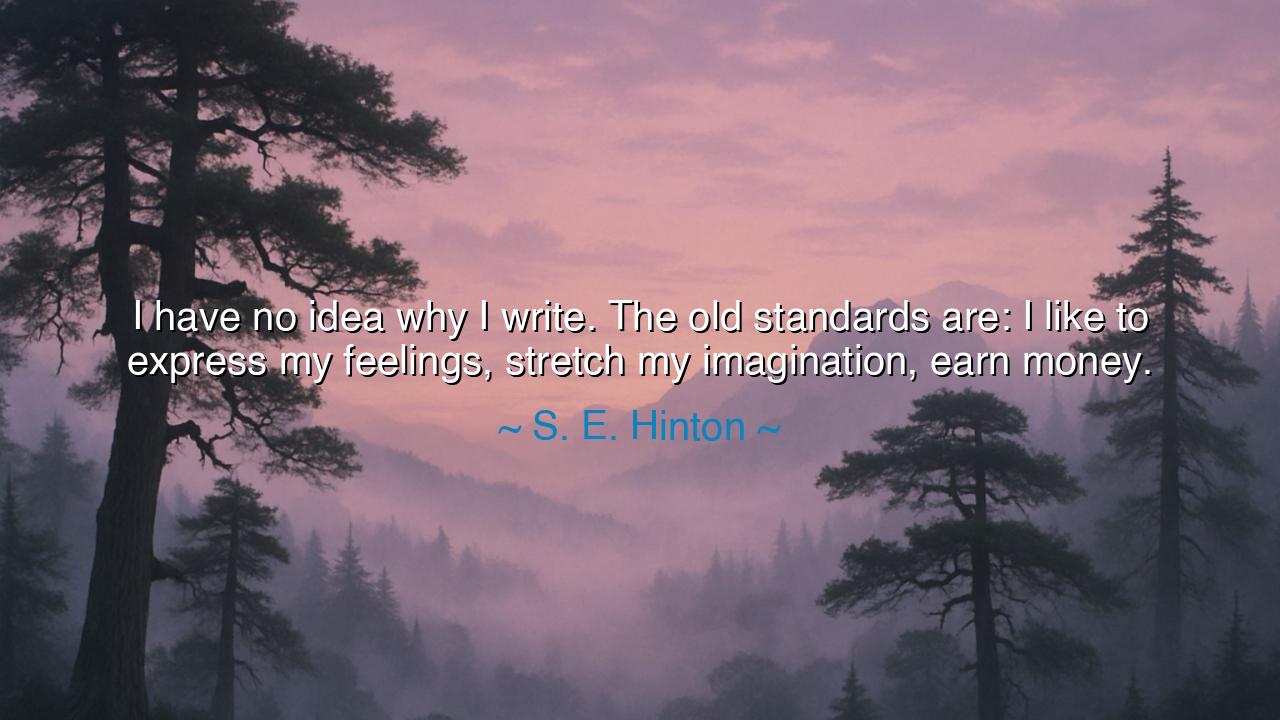
I have no idea why I write. The old standards are: I like to
I have no idea why I write. The old standards are: I like to express my feelings, stretch my imagination, earn money.






The words of S. E. Hinton — “I have no idea why I write. The old standards are: I like to express my feelings, stretch my imagination, earn money.” — carry within them both humility and mystery. Spoken by the young woman who, at only sixteen, wrote The Outsiders, they reveal a truth that every creator knows but few dare to admit: that the act of creation often transcends explanation. Hinton’s confession — “I have no idea why I write” — is not ignorance, but reverence. She speaks as one standing before a sacred fire, knowing that its light sustains her, even if she cannot name its source.
In the ancient tradition, the poets and prophets often spoke of inspiration as a force outside themselves. The Greeks called it divine madness, the breath of the Muses. The Hebrews said the word of God descended upon the poet’s tongue like fire. Hinton’s words echo this lineage: she does not claim mastery over her art but surrender to it. When she says she writes without knowing why, she acknowledges that imagination is not a tool of the will, but a river flowing through the soul — one that carries her to unknown shores. The writer, in this view, is not merely a maker, but a vessel for something timeless.
And yet, she also grounds her mystery in simplicity: “I like to express my feelings, stretch my imagination, earn money.” These are the old standards — the tangible reasons we give for art. To express feelings is to empty the heart of its storms, to make sorrow and joy visible upon the page. To stretch the imagination is to test the limits of thought, to reach beyond the known world. And yes, even to earn money — for the artist, like all mortals, must live in the realm of bread and fire. But beneath these reasons lies the deeper current she hints at: the urge to create that predates reason itself, the call that comes not from the mind but from the marrow.
Consider the example of Emily Dickinson, who wrote nearly two thousand poems yet published only a handful in her lifetime. She, too, could have said, “I have no idea why I write.” She wrote in solitude, not for fame or wealth, but because the words would not leave her in peace until they were born. Her poems, like Hinton’s novels, came from the quiet compulsion of truth seeking form. This is the hidden law of creation: that sometimes, one writes not out of purpose, but out of necessity — because the soul cannot remain silent.
Hinton’s imagination was forged in the fire of youth. When she wrote The Outsiders, she sought to tell the story of class and conflict from the eyes of teenagers — something the literary world had not yet seen. Her book gave voice to the voiceless, dignity to the misunderstood. Yet she claims she did not know why she wrote it. Perhaps that is the mark of true creation — when the artist becomes a bridge between the unsaid and the spoken, unaware of the greatness of the path she walks. Her not knowing is a kind of purity, untouched by vanity or design.
In her words, we find a gentle warning to the generations that follow: do not demand that your art justify itself. The why of creation is not always answerable. The ancients understood this — they did not ask the bird why it sings, or the river why it flows. The act itself is its own reason. When one writes, paints, sings, or builds, one participates in the eternal act of becoming, joining the divine dance of creation that sustains the world. To question it too deeply is to miss its grace.
Let this then be the lesson: create because you must. Do not wait for perfect purpose or explanation. Express your feelings boldly, for they are the pulse of your humanity. Stretch your imagination, for that is how the soul grows wings. And do not despise the worldly rewards of your labor — for even the sacred must live in the world of flesh. But above all, remember that imagination is not a tool, but a gift. Honor it with humility. When you do not know why you create, smile — for that unknowing means the mystery is still alive within you.
And so, as the ancients would whisper to their apprentices: “The fire does not explain itself; it simply burns.” S. E. Hinton’s words remind us of this same truth — that to write, to dream, to imagine, is to stand before the eternal flame and offer one’s heart to it. Do not fear the mystery; embrace it. For in that mystery lies the soul’s most beautiful answer to the question of why we are alive at all.






AAdministratorAdministrator
Welcome, honored guests. Please leave a comment, we will respond soon